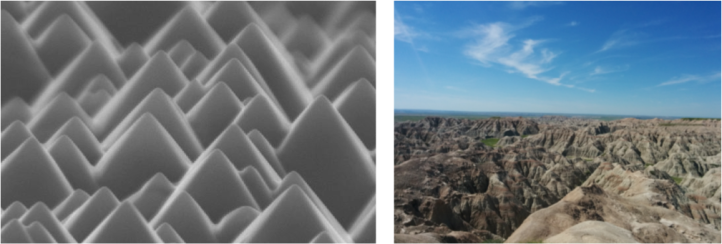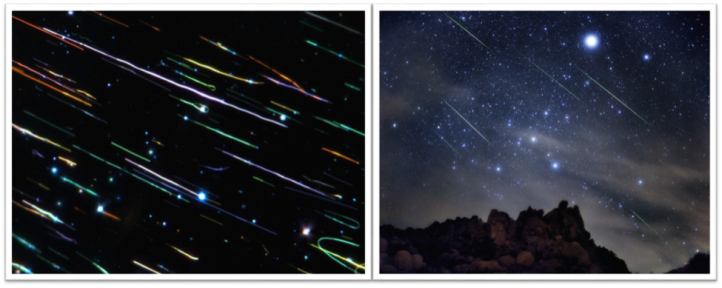Towering mountains are stretching beyond my sight, flaming roses are blossoming by my side, shooting stars are dashing above my head. You might think that I am traveling to some wondrous destination, wandering in a mountainous area and enjoying the dark expanse of the glorious starry night, but what if I were to tell you that I’m actually talking about both nature AND nanoscience?
Welcome to this wonderful nano journey. Together we will encounter three examples of nanoscience resembling nature. First up, standing in front of us are both nanosize mountains and mountains in Badlands National Park, but it might not be obvious at first which one is which.

If you saw the sky in the picture on the right, you probably guessed right away that it shows the real mountains of the Badlands. But the “mountains” on the left are almost as amazing: they are nanopyramids etched on the silicon surface of a solar cell.
Silicon has been used in solar cells for a long time. If the silicon surface is too clean and smooth, too much light reflects back, making the solar cell less efficient. To fix this problem, people have developed different etching methods to make the surface a little rougher so it absorbs more sunlight. One such technique has led to the formation of nano pyramids shown in the picture. If we think out of the box, we find these nanosize pyramids resemble the mountains located at the Badlands National Park. While hiking in the park, I was shocked at the similarities between these gorgeous mountains and the surface of etched silicon. It’s like Mother Nature created one giant solar cell electrode!
After gazing in awe at the majesty of the mountains, let’s continue on our journey. About halfway up the mountain, there comes a perfume of flowers. What is that? Oh, nanoflowers!

Were you able to guess that the actual flowers are on the right in the above to pictures? The picture on the left is a nano-enabled textile fiber composed of two different materials. One of those, manganese dioxide (MnO2), is a cheap material used often in electronic devices due to its ability to store a large amount of electric charge. However, it is not good at conducting electric current, which has impeded its further applications. Thus, researchers have been trying to combine MnO2with nanomaterials of high conductivity, such as carbon nanotubes (CNTs). In the image on the left, nanoscale MnO2 was deposited onto CNTs, forming a MnO2-CNT textile fiber.1 This architecture gives us the best of both worlds – high capacity or charge storage (from the MnO2) and great conductivity (from the CNTs). The inset in the image shows the original nanostructure. With some artificial coloring, they look very similar to the real roses on the right side. So, if you are chasing a date in material science, perhaps these marvelous nanoflowers may be more effective. C’mon, try it, STEM nerds!
Finally, we’ve almost reached the end of this exciting nano journey, the peak of the mountain. Night falls and the Milky Way covers the deep sky with its mysterious veil. Look! There they come – it’s a meteor shower!

The left hand picture comes from a process where scientists were assembling nanowires (very small wire-shaped materials made out of tellurium) on a polymer film.2 Films like this are excellent semiconductor materials that can be used in electronic devices like high performance gas sensors. These colorful wires look extremely similar to those shooting stars dashing through the night sky shown on the right. If you like the meteor’s streak and arc of the nanowire arrays, go ahead and make a wish and perhaps one day your wish will come true!
Though it was a transient trip to the nanoworld, what we have encountered above is just the tip of the iceberg. I hope you’ve noticed that science, art, and the natural world we can see with our own eyes are not totally different. Scientists are dealing with aesthetics, and artists can find resonance from these shocking nano-views. Nanoscience is fascinating- some people derive powerful technology from it, while others are creating art!
EDUCATIONAL RESOURCES
- Sustainable Nano post by Autumn Qiu: There’s Plenty of Room at the Bottom… for Art!
- UCLA Sci/Art Nanolab – summer program for high school students
- Scholastic.com – Art Integration: Easy Ideas Combining Science and Art (grades 1-8)
REFERENCES
- Xia, H. et al. Hydrothermal synthesis of MnO2/CNT nanocomposite with a CNT core/porous MnO2 sheath hierarchy architecture for supercapacitors. Nanoscale Research Letters, 2012, 7, 33. doi: 10.1186/1556-276X-7-33
- S. Wu, et al. Soluble Polymer-Based, Blown Bubble Assembly of Single- and Double-Layer Nanowires with Shape Control. ACS Nano, 2014, 8, 3522-3530. doi: 10.1021/nn406610d

I love this blog post so much! Very creative. And the science is so cool!
Thanks, Ricky! I always believe science and the nature are connected somewhere. 🙂